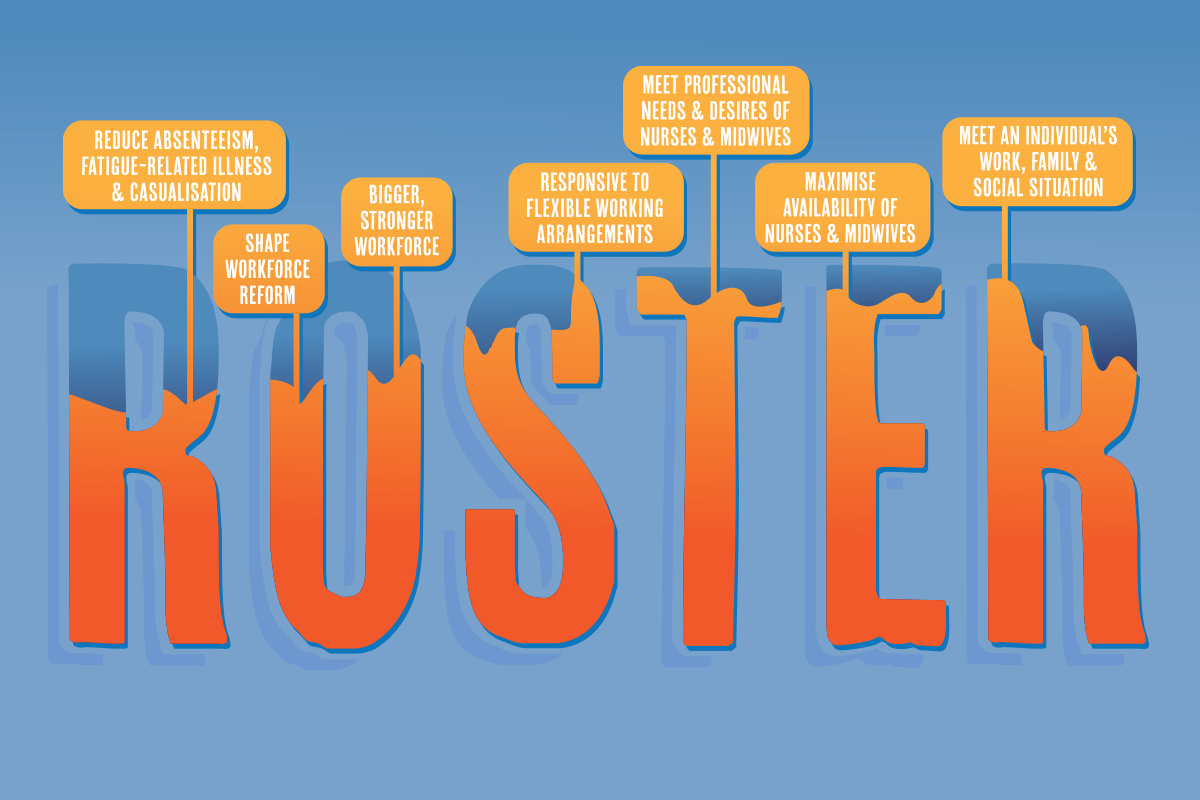
ANMF (Vic Branch) is working with Safer Care Victoria, the Department of Health and three Victorian health services in 2023 to investigate changing the way we roster in Victoria. This project aims to address flexibility by creating a set of guidelines that will support more employee-centred rostering.
The aim of the project – which builds on the workforce retention survey of public sector members that the Branch conducted in 2022 – is to find best-practice ways to create rosters that:
- build a bigger, stronger workforce
- help shape workforce reform
- maximise the availability of nurses and midwives
- reduce absenteeism, fatigue-related illness and casualisation
- meet an individual’s work, family and social situation
- are more responsive to flexible working arrangements
- meet the professional needs and desires of nurses and midwives.
We want to build rosters that facilitate set shifts/set days, and which are responsive to requests for flexible work arrangements. We want to build rosters that adhere to best-practice fatigue-management principles. We want to look at the roster’s ability to accommodate any EFT fraction for a permanent employee.
It’s a daunting task, but the benefits should not be underestimated: rostering to ratios and fixing rosters have the potential to significantly improve retention and satisfaction rates among existing nurses and midwives, and among those joining our professions over the coming years.
‘This is a really big and important project,’ says Branch Secretary Lisa Fitzpatrick. ‘It will look at the current state of play, but it’s also going to look at where we want to be with rostering and what workforce benefits we would see from improving rostering processes. If we achieve good outcomes we can then embed those in the 2024 public sector EBA and health service operations.’
Stage 1 underway
A project manager is being recruited at each of the trial sites, and the first stage of the research – the distribution of two surveys: one for nurses and midwives, and one for unit managers of participating wards/units – is now underway. This will be followed up with co-designed focus group workshops that will target the issues identified from these initial surveys.
The project will also look to learn from other 24/7 sectors that rely on rotating rosters, such as aviation and transport.
Draft guidelines will then be developed based on these initial surveys, focus groups and research. Further surveys will follow to determine if the draft guidelines are working as intended for nurses, midwives and health services.
What does success look like:
- Nursing and midwifery are recognised as professions that offer choice, capitalising on availability of nurses and midwives as well as being able to meet the needs of those in our care.
- Available technology is maximised to reduce the time demands and other impacts on those with the responsibility of rostering.
- Rosters are built ensuring that any set shifts/set days an employee requests enable flexible work arrangements to be met (subject to ‘built in’ and agreed periodic review).
- Where applicable, consideration is given to an employee’s preference in terms of location and shift preferences within a ward/unit or multi-ward service (e.g. birthing suite, oncology).
- Fatigue management and best-practice shift-work principles (e.g. day to evening to night) are utilised.
- The requirements behind the need for flexibility are understood – including childcare start and finish times, alternate childcare options, other shift options around childcare availability, partner work requirements and other care requirements.
- Understanding how far in advance is optimal for staff to have the roster released.
- Any EFT fraction for the purposes of being a permanent employee is recognised and considered.
- The 26-hour roster to enable CPD time is retained.




